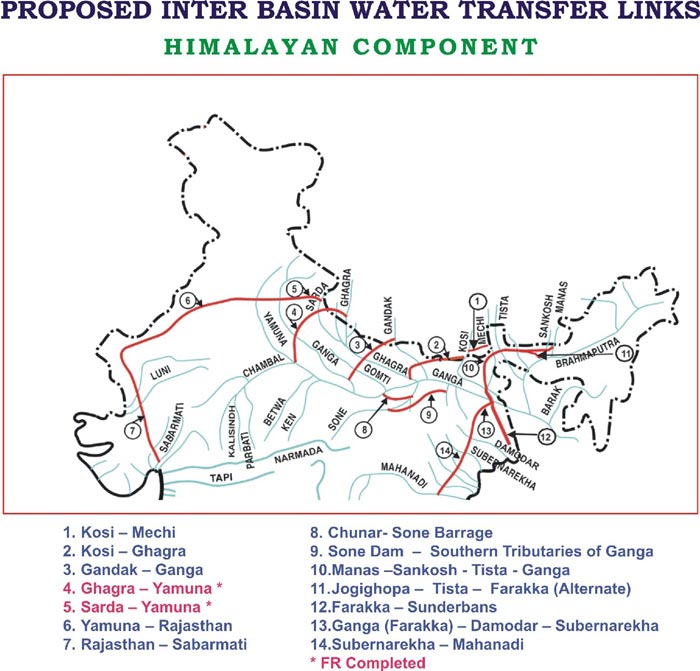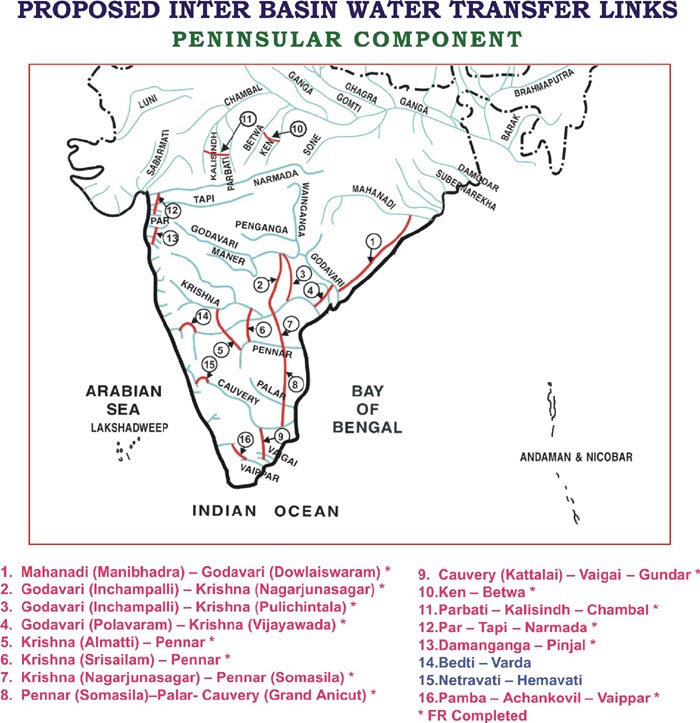IASbaba's Daily Current Affairs Analysis, IASbaba's Daily Current Affairs July 2015, International, National, UPSC
Archives
IASbaba’s Daily Current Affairs- 14th July, 2015
NATIONAL
Interlinking of Rivers: Challenges
- Inter-linking the great rivers of India is a dream that has been around for a while. The idea was first proposed in 1970’s and revived again in 2003 but nothing concrete has been done till date.
Advantages of this project:
- Problems related to flood control, irrigation, limiting droughts and boosting farm output—can be sorted out by linking the country’s rivers.
- Potential benefits to transport infrastructure through navigation, as well as to broadening income sources in rural areas through fish farming.
But, what about the feasibility of the Project ?
- A north to south inter-linking of rivers is physically not possible. The barrier imposed by the Vindhya mountains makes it expensive to lift water along the north and south axis. It is also unnecessary.
- Henceforth, the river-water linking plan – one for peninsular India and the other for linking rivers from the east to the north is an ideal solution.


Courtesy – http://www.nwda.gov.in/
Other issues:
- River inter-linking is an expensive business from building the link canals to the monitoring and maintenance infrastructure. Implementation of the project not only needs a huge financial capital but also political support, both are scarce commodities as of now.
- Another important issue is building consensus among states and Land acquisition.
- Once the project is implemented it would lead to large scale displacement of people and animals. Hence appropriate rehabilitation measures should be taken by the Government.
- A careful scientific assessment of the project and its impact on the environment, is necessary in case of a project of this magnitude especially with regard to Biodiversity,
Background:
- The Indian Rivers Inter-link aims to link India’s rivers by a network of reservoirs and canals and so reduce persistent floods in some parts and water shortages in other parts of India.
- The Inter-link project has been split into three parts: a northern Himalayan rivers inter-link component, a southern Peninsular component and starting 2005, an intrastate rivers linking component.
- The project is being managed by India’s National Water Development Agency (NWDA), under its Ministry of Water Resources.
National Water Development Agency (NWDA):
- National Water Development Agency (NWDA) was set up in July, 1982 as Autonomous Society under the Societies Registration Act, 1860, to carry out the water balance and other studies on a scientific and realistic basis for optimum utilisation of Water Resources of the Peninsular rivers system for preparation of feasibility reports and thus to give concrete shape to Peninsular Rivers Development Component of National Perspective. In 1990, NWDA was also entrusted with the task of Himalayan Rivers Development Component of National Perspectives.
Connecting the Dots:
- What can be the practical solutions to the above mentioned issues, regarding interlinking of rivers? (Or) How effectively can this project can be implemented?
- Impact of Interlinking of rivers on all the stakeholders involved from the Central Government, State Governments, common man to the environment?
- What is your take on this project? Yes/No. Justify.
INTERNATIONAL
Liability law still clouds nuclear deal
Led by U.S. Vice-President Joe Biden, senior Indian and U.S. officials sent out a strong signal of their commitment to moving the bilateral civil nuclear deal forward despite obstacles

What is the bilateral civil nuclear deal?
- The 123 Agreement signed between the United States of America and the Republic of India is known as the U.S.–India Civil Nuclear Agreement or Indo-US nuclear deal.
- This U.S.-India deal took more than three years to come to fruition as it had to go through several complex stages, including amendment of U.S. domestic law, especially the Atomic Energy Act of 1954, a civil-military nuclear Separation Plan in India, an India-IAEA safeguards (inspections) agreement and the grant of an exemption for India by the Nuclear Suppliers Group, an export-control cartel that had been formed mainly in response to India’s first nuclear test in 1974.
What kind of technology would India receive in return?
- India would be eligible to buy Nuclear Technology from Nuclear Suppliers Group(NSG).
- There are 45 countries in NSG.
- India will get Nuclear reactor and nuclear fuel for making power for energy.
- India will become the only one country that gets nuclear technology without signing Nuclear Non-Proliferation Treaty.
Connecting the Dots
- Explain the India’s three stage nuclear power programme
- Write a note on Nuclear Power in India.
Dire need for a global consensus on refugees
- Over the past few months, the headlines have been dominated by the plight of people fleeing their countries and seeking refuge elsewhere.
- With several recent instances of migrants being left in the lurch, the international community must arrive at a consensus to protect refugees
Who is a refugee?
- A refugee is a person who is outside their home country because they have suffered (or feared) persecution on account of race, religion, nationality, or political opinion;
- Because they are a member of a persecuted social category of persons; or because they are fleeing a war.
Who are in need of refugee Norms?
- Perhaps of greater significance to the majority of today’s refugees is the emerging customary norm of temporary refuge, which prohibits a state from expelling foreign nationals who have fled armed conflict and civil strife.
- Such persons are not the targets of persecution but are innocent civilians whose own government cannot guarantee their safety.
- The situation in Syria perhaps represents the need for such a norm.
What is the Responsibility of International Community?
- It is the responsibility of the state to protect their citizens.
- When the governments of home countries are not able or willing to protect the basic rights of people living in the state and these people are forced to cross an international border to escape persecution, generalized violence, conflict, or serious human rights violations, then the international community has the responsibility to step to ensure that these people receive effective protection and that their basic rights are respected.
- The creation of national refugee legislation based on International standards is the key to strengthening asylum, making protection more effective, and developing solutions for refugees
IAS BABA’s View
- India, with its long history of providing shelter to the persecuted, is uniquely positioned to take the le
- India, with its long history of providing shelter to the persecuted, from the Zoroastrians to, more recently, the Tibetans, is perhaps uniquely positioned, particularly in the Asian subcontinent, to take the lead in any international consensus building on the subject.
Connecting the Dots:
- What is the role and mandate of UNHCR?
- To what extent are the provisions of the 1951 Refugee Convention reflected in the legislation of India?













